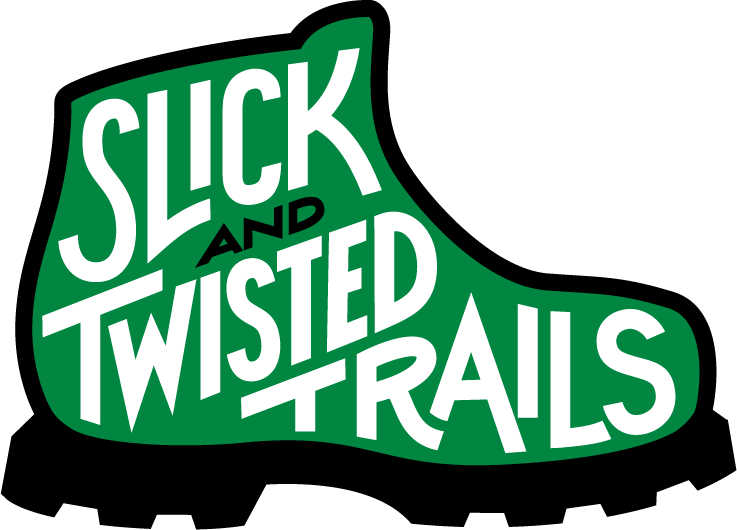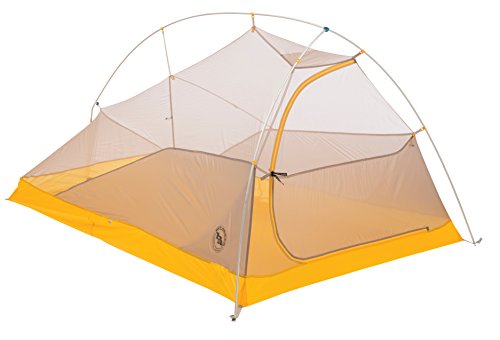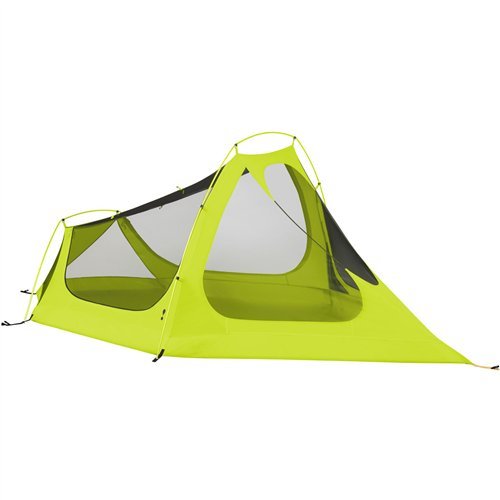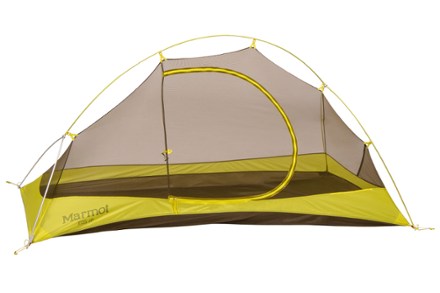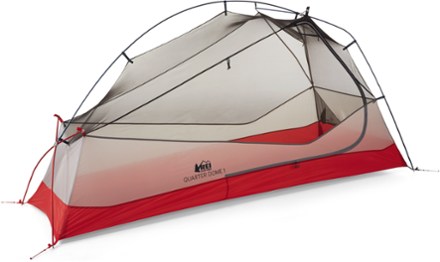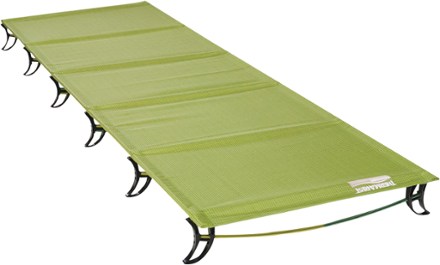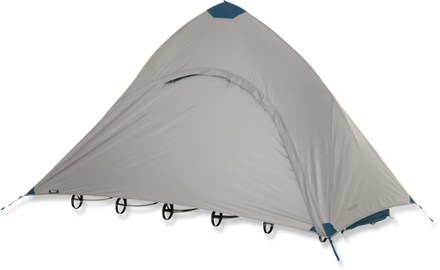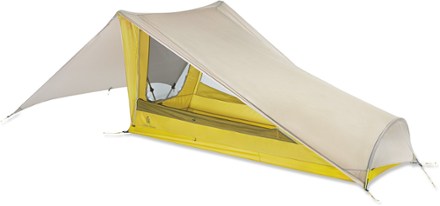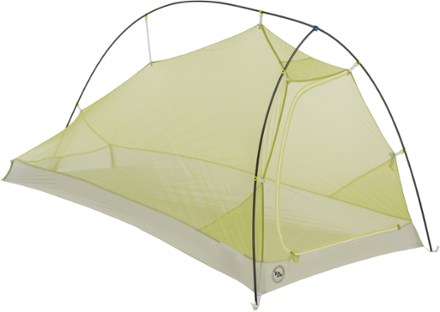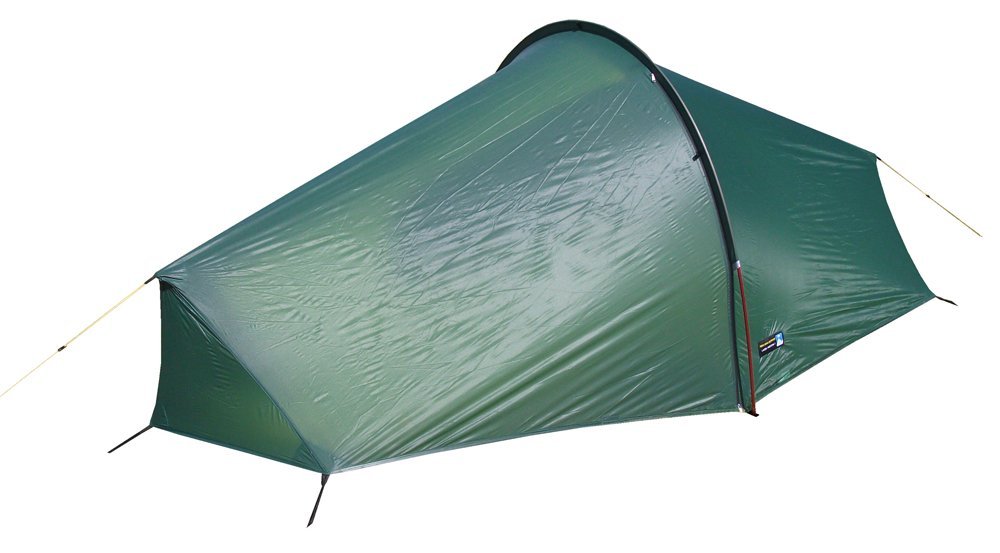Your outdoor shelter / backpacking tent is the most important purchase you can make before a trip, it is the difference between life and death.
From my experience, nothing beats using a tent. It is a versatile shelter, making it easy to setup and easy to carry.
Tents have saved me from hypothermia when caught in a July snowstorm down in Patagonia, they’ve made sleeping in mosquito-ridden swamps possible and even gave me some much-needed privacy on the Appalachian Trail.
Picking the best backpacking tent can be like drinking from a firehouse: the amount of diversity on the marketplace is a bit overwhelming. And that’s where this article comes in.
First, let’s organize these tents into three main categories:
Two Person Tents
Built to sleep two people, these tents are perfect for couples and car campers. I will not discount their utility for solo hikers who enjoy their space!
One Person Tents
Built for the lone traveler, the vagabond of the backcountry, these tents are built for one person. Perfect for solo travel and those wishing to sleep alone.
Lightweight Tents
Built from the lightest space age materials, these tents are focused on shaving as much weight from a pack as possible. Perfect for long distance hikers and gram counters, some models are almost tarp like in their construction.
Using these categories as your metric, let’s dive into the models and discover which one is right for you.
This article will be covering the very best backpacking tents on the market, determined by both value and quality. If you want to find the cheapest options, check out this review of the best backpacking tents under $200 instead.
5 Tips For Finding The Best Tent For Backpacking
Understand where you are going and which tent will provide the best shelter. Hiking in the desert will require a much different tent than hiking on the East Coast. Rain, bugs, and temperature are the most formidable of obstacles in the backcountry; keep these conditions to keep in mind.
Have a plan for how long will you be backpacking. If you more of a weekend hiker a larger tent that is more comfortable can be a superior choice over an ultralight model.
Know how many people will be sleeping inside the tent, if you have a significant other, buying a one person tent might cause some tensions on the trail. Be sure to match the tent to the people who will be inside.
Set limits for yourself. Whether these be weight restrictions or comfort guidelines, knowing your limits will make finding the perfect tent easier. If you are claustrophobic, maybe the smaller tent is not right for you. Small and large people will have different models that fit their heights better.
Visualize the size of the tent; this goes for the footprint of the shelter as well as its pack size. Understand how it will conform to your pack, and determine the amount of space that will be needed to set it up.
Backpacking Tent Reviews
All of the tents featured are the best of the best. We only picked from reputable manufacturers that have been field tested by the most extreme backpackers. We broke down each review into 4 distinct categories: set up size, weight and pack size, durability, price.
Set up size:
How large a tent is when fully erected, head room and footprint are counted. Any vestibules will be measured separately.
Weight and pack size:
How heavy and how much space the tent takes up when it is fully packed down.
Durability:
The materials the tent is made from as well as its waterproof capabilities.
Price:
Nothing in this list is a budget tent but price is always a determining factor.
Best Two Person Tents
Set up size: 40 inches high at the tallest point, this tent allows for most people to sit up comfortably. 52 inches wide and 86 inches long, the tent will sleep two people, albeit with little room for much else. The single pole construction makes it free standing, no need for stakes to keep the tent erect. Although, setting up without stakes will leave the tent limp and not prepared for wind and storms.
The Vestibule allows for 8 square feet, just large enough for a couple packs and pairs of shoes, you will have to tetris to make it all fit.
Weight and pack size: 2lb 5oz, making this one of the lightest two person tents on the market. Its pack size of 4” x 19” is also relatively small and will fit nicely in even the smallest of packs. One of the smallest and lightest two-person tents on the market.
Durability: The fly and the floor are treated with 1200mm polyurethane coating and will keep you dry. In the heaviest of storms, the rain will mist through the rainfly, but the water will not become a nuisance.
Thin materials keep this tent lightweight, this means nothing is opaque and if you are looking for privacy during daylight hours, it will not happen.
Set up size: 3 feet 7 inches tall, most everybody will be able to sit up comfortably. The floor is 129 inches by 70 inches which makes it ample for two people. The unique arrow shape in the front of the tent leaves plenty of room for gear, basically an indoor vestibule.
This is not a freestanding tent, two poles are required for set up, one in the front and another in the rear. Heavy and bulky but it holds up, I used the one person model on my Appalachian Trek and I really loved it.
Weight and pack size: 4lb 3oz, the Eureka Spitfire is not a lightweight shelter. But her pack size of only 6×18 inches will let this model fit in most packs. A good trick to reduce weight is to invest money in aluminum or titanium stakes, that alone will get this tent under 4lbs.
Durability: The fly and the floor are made from 75D 190T Stormshield(c) polyester taffeta, which if you did not know, is a very strong and impermeable material. Much thicker than most other tent materials on the market, this is a bullet proof shelter.
Durability is the reason this tent made it on the list, especially on long distance hikes, I hate when my gear fails. All these lightweight tents do end up wearing out and ripping after many months on the trail. If you want a tent that you do not have to baby, this is the model for you.
Set up size: 40 inches tall at the peak, this tent is for lightweight duo hikers who want to be able to sit inside comfortably. The floor is 51 inches wide at the head, 85 inches long, and only 43 inches wide at the feet, a snug fit for two people.
Nearly identical to the Big Agnes Fly Creek, the double entry doors and two vestibules really sets this model apart. When I am hiking with another person, being on top of each other inside the tent is always a point of contention. This design allows for as much privacy as possible in a shelter that barely weighs over 2lbs.
Weight and pack size: 2lb 5oz, the NEMO Hornet 2p is extraordinarily light weight, and is competing with Big Agnes for a shelter around 2lbs for two people. With a pack size of 19×5 inches, the tent can also be distributed between two people, featuring double stuff sacks.
Durability: The fly and the floor are made from 1200mm rip stop nylon and will make a waterproof set up. The nylon is as thin as possible while maintaining waterproofness, be careful with setup and teardown.
The same lightweight material as Big Agnes uses, you will have to be careful with this tent. Drying it out after a couple days of rain will be a priority because the fly material does become saturated fairly quickly.
My top pick!
The Nemo Hornet 2p tent is my pick. The double vestibules and double doors make it very easy to have privacy while sharing a tent. Having all that space with a weight of barely 2lb 5oz is a great accomplishment and this model really stands above the rest because of that.
Almost free standing and very similar to the Big Agnes tent, the Hornet 2p’s small size and packability makes it that much easier to bring with you wherever you go.
Best One Person Backpacking Tents
Set up size: 36 inches tall at its highest, 87 inches long, and 37 inches at the head and 30 inches wide by the feet, Marmot has created a very serious one person tent.
The vestibule offers almost 8 square feet and features a side door for easy access.
I like the vestibule size as well as the general interior of the tent. It by no means reinvents anything but for its price, size, and durability, this tent will make a fine addition to any solo hiker’s pack.
Weight and pack size: At 2lb 15oz, this model is under the 3lb mark, making it an excellent choice for backpackers. With a pack size of 18.5×6 inches, the tent is no record ultralighter but it will suffice for most backcountry trips.
Smaller than most other tents on the market, you will not be obsessing over the weight in your pack if you go with this model.
Durability: Double pole construction, made from DAC featherlite material will withstand most high winds.
The floor is made from 30 denier fabric, the fly from 20 denier ripstop polyester, making it a thicker material than some other tents on the market. This material is much better under the stresses of intense rainstorms and you will stay dry inside.
Marmot is known for using heavier yet stronger materials in their design. If you are traveling long distances or are generally hard on your gear, this is a model built with you in mind.
Price: At $259.00, this tent is priced for the more budget friendly crowd. The heavier materials make this model bulkier but its durability is what makes it stand out. This is a good tent for hikers who do long weekend trips and might be flirting with the idea of a long distance trek.
Set up size: 42 inches tall, 88 inches long, 35 inches at the head and 27 inches by the feet, this is a very spacious solo tent. It is also free standing without needing to be staked down.
The vestibule offers about almost 10 square feet and features a large top to bottom zipper that makes entry and exit a breeze. There is a lot of space with this model, the most out of any other tent on the list. If you like to read or write on a rainy day without feeling claustrophobic, this is a very good choice.
Weight and pack size: At 2lb 14oz, this model keeps it under 3 pounds and offers plenty of space. With a pack size of 18.5×6 inches, this tent keeps a remarkably small pack size for what it offers.
Durability: Only a single pole is used, which is neat because the amount of aluminum used for setup looks more complicated than it is.
The floor and rainfly are made from 1200mm rip stop nylon, making it the lightest materials on the market. Not the most impermeable, a heavy rainstorm will thoroughly soak the rainfly but it will keep you dry.
Price: at $279.00, this tent is made for the camper who can shell out a little extra for comfort and weight. The very large interior makes this model stand out from the crowd and REI should be proud of what they built.
Set up size:The cot portion is, 77 inches long, 26 inches wide, and is a great option for people who have a hard time sleeping on the ground.
There is a rainfly and bug net attachment that is available as well, at 55 inches tall, the tent attachment is ample for ventilation and bug resistance.
Definitely heavier than most shelters, this is a perfect option for those looking for maximum comfort. The reason I added this tent is because many people on the trail do have bad backs or a physical injury which makes sleeping on the ground difficult. This model is the best option I have found for alleviating the back problems that plague so many enthusiasts.
Weight and pack size: At 2lb 12oz, this is the lightest cot on the market and at this weight, it makes a very realistic option even for thru-hikers. It packs down to 6x15inches which is similar to most tents on the market.
You will need to purchase a rain fly and/or bug net for serious hikes which will add to the weight and pack size. The tent attachment does weigh 2lb 12oz but if you have back pain or trouble sleeping on the ground, maybe a more basic tarp set up will suffice.
Not the lightest option by a long shot but it is the most comfortable. This model is built for the avid outdoorsman who can’t rough it like they used to.
Durability: The cot, rainfly, and bug net are all extremely durable, foregoing the space age materials and using heavier, stronger fabrics. Thermarest is known for making gear that holds up under the rigors of the outdoors, the weight of the gear is secondary.
The floor and rainfly are made from 1200mm rip stop nylon, making it the lightest materials on the market. Not the most impermeable, a heavy rainstorm will thoroughly soak the rainfly but it will keep you dry.
My top pick!
REI Quarter Dome 1 tent is my top choice of solo tents. Easy to set up and incredibly spacious, this tent offers an excellent escape from the elements. Space can become a huge issue, especially if you are stuck inside for days on end due to rain. This tent is perfect for solo adventurers who want elbow room without getting wet.
I am also very intrigued with the cot tent, having spent many an uncomfortable night on the ground. If technology improves and this option becomes lighter, I am confident it will become my go to.
Best Lightweight Backpacking Tents
Set up size: 41 inches tall, 88 inches long, 30 inches at the head and 20 inches by the feet, this is tent is built for lightweight camping only. Not a freestanding model, it uses trekking poles to keep it upright.
The vestibule offers 8 square feet of dry area, large enough for any pack. What intrigued me with this model is how tall it is, 41 inches is more space than any other lightweight tent on the list.
The top of the tent is wider than the floor, meaning there is more space for the head and shoulders than a dome or A-frame tent. There is also quite a bit of ventilation and the sides can be opened up completely in nice weather.
Weight and pack size: At 2lb 6oz, this tent is designed for ultra lighters, using trekking poles for support to keep the weight down. 17.5×4.5 inches pack size means this tent is perfect for a solo pack.
Durability: No poles are used which in turn means less moving parts that can break but you will have to trust in your trekking poles.
The floor is made from 30 denier ripstop nylon and the fly is made from 20 denier ripstop nylon, a bit thicker than some of the tents featured in this article. The rainfly is integrated as the roof which makes condensation an issue, single wall designs tend to bottle up breath and sweat in the interior.
Set up size: 39 inches tall at the peak, this tent is designed to shave as much weight and size as possible. 86 inches long, and only 38 inches at the head and 28 inches wide by the feet, the shelter offers a similar footprint to a bivy.
The vestibule offers about 5 square feet of space, just large enough for a pack and a pair of shoes. The single pole construction makes this tent freestanding, but it needs to be staked out to be a fully protected shelter.
Not very large, there is no wasted space in the design, when I used this tent down in Patagonia I absolutely loved it. I did have to be careful about letting my sleeping bag brush against the walls or else it would get wet but you learn fairly quickly. If you are any larger than 6 feet, it might be a good idea to try this tent out before buying it.
Weight and pack size: At 1lb 13oz, Big Agnes bills this tent as the lightest freestanding tent on the market, and I believe them. Ultralight and ultra small, with a pack size of 15×4 inches, it is easily stuffed into any backpack.
Durability: The single hub pole made from DAC aluminum will hold up under the rigors of travel.
The fly and the floor are made from 1200mm rip stop nylon, making a thin and almost see through double wall design. You will stay dry but the tent will need to dry out after a night of rain. It survived some massive winds and snowstorms and on my return to the State’s, Big Agnes replaced the interior no questions asked.
Set up size: 37 inches tall at the peak, and only 26 inches wide at the feet, this is an ultralight shelter where every possible gram has been shaved off. The double walled construction separates this shelter from a bivy and offers just enough space to change clothes comfortably.
The vestibule offers about 8 square feet, large enough for the lightweight pack that is assumed to be associated with the user. The smallest and most lightweight tent on the list, you will have little room to do much more than sleep.
Weight and pack size: At 1lb 12oz, this model advertises itself as the Guinness World Record holder for the lightest manufactured tent. Using titanium stakes and a single aluminum hoop, no expense is spared to reduce weight.
If you want to have the lightest shelter on your back while enjoying all the benefits of a tent, then this model is for you.
Durability: The rainfly is made from the thinnest silnylon on the market. Sturdy enough to hold up against snow and rain, be careful not to touch the material as you will get wet.
As with any tent made from lightweight nylon, you will need to dry it out after consecutive days of rain. Be careful when setting up on rocks and cactus spines as they can puncture and tear the floor quite easily.
My top pick!
Big Agnes Flycreek HV 1 is my top pick, it is also the tent I personally use. It has survived snowstorms and thunderstorms, even bouncing back from wind speeds of over 60 mph when I took it down to Patagonia.
Its lightweight size and surprisingly strong construction makes me confident enough to recommend this tent. I am a big fan of the Big Agnes warranty, they replaced the body of the tent when the bug lining began to rip from the zipper with no questions asked. You really do get what you pay for.
Your Tent and You
Choosing the proper shelter is a very personal choice, your tent will be the most important investment of your outdoor experience. Remember, you will be spending hours of your time inside, be sure to pick a model that will compliment your backpacking style.
Looking over this list will hopefully illuminate the decision making process and help you on your next adventure. Your tent is truly your second home, make sure you choose the right one!
